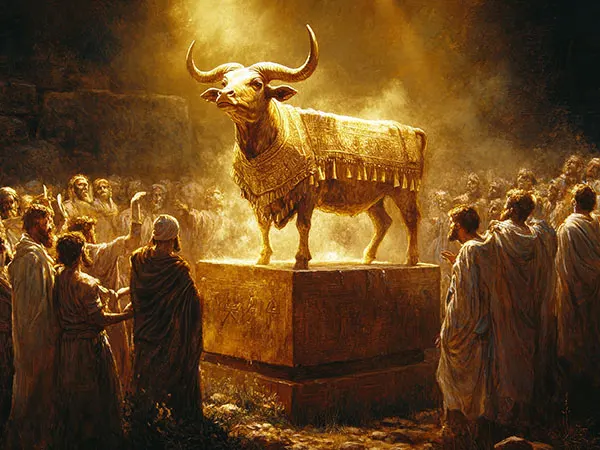Filter by Categories
The Holy Spirit and the Trinity (Part Seven)
Sermon by John W. RitenbaughIn the layout of the Tabernacle in the wilderness and the Temple in Jerusalem, the Holy of Holies represents the very presence of God, barred by a veil that prevents direct access. This veil symbolizes the separation from God, and only by passing behind it could one enter into His immediate presence. At the crucifixion of Jesus Christ, as recorded in Matthew 27:50-51, the veil was torn apart, signifying that a personal relationship with God can now be established. This access to the Holy of Holies, into God's presence, is crucial for transformation from glory to glory, emphasizing the importance of drawing near to Him. Without this closeness, there is little hope for spiritual growth or transformation, underscoring the need to seek God continually to nurture and maintain this vital relationship.

Prepare to Meet Your God (Part Five): Religion and Holiness
Article by John W. Ritenbaugh and Richard T. RitenbaughGod told Israel that He would dwell in the Tabernacle, specifically in the Holy of Holies, a profound symbol of His presence. Inside the Holy of Holies, the most crucial piece of furniture was the Mercy Seat, a wooden chest overlaid with gold, its lid functioning as the seat. Stored within the chest, under the seat, were the two tablets of stone, symbolizing God sitting on His law, the foundation of His judgment. When a man sins, he separates himself from fellowship with God, no longer permitted to come into the Holy of Holies. To restore this broken relationship, on the Day of Atonement, once a year, the high priest entered the Holy of Holies to sprinkle the Mercy Seat with blood, showing that the blood covered the transgressions of God's law. Through this act, the redeemed were again in fellowship with Him. The law and the blood are essential for maintaining the correct relationship with God, with the law being permanent and the blood available to cover any transgression of it.
The Great Mystery
Sermonette by Gary GarrettAdam and Eve originally had a most enviable relationship with the Creator, as well as access to the Tree of Life, if they had chosen it.
A Feast Message From Hebrews
Feast of Tabernacles Sermon by John W. RitenbaughThe Bible shows a clear pattern of how people leave the faith: looking back, drawing back, looking elsewhere, and then going backward and refusing to hear.
Amos (Part Nine)
Sermon/Bible Study by John W. RitenbaughAncient Israel regarded Bethel, Gilgal, and Beersheba as a sacred shrines, but were not becoming spiritually transformed as a result of pilgrimages.
Government (Part Four)
Sermon by John W. RitenbaughFor us to take on the glory of God, we must have the same kind of access to the Father as Christ did, taking on the responsibility of behaving like His sons.
Eden, The Garden, and The Two Trees (Part Three)
Feast of Tabernacles Sermon by John W. RitenbaughJesus' crucifixion took place outside the camp of Israel, just outside the border of the Garden of Eden, the general area where the Miphkad Altar stood.
Hebrews (Part Ten)
Sermon/Bible Study by John W. RitenbaughEverything about the Priesthood of Christ is superior to the Levitical system, which only served as a type of the access to God that Jesus would fulfill.
Eden, The Garden, and the Two Trees (Part Two)
Feast of Tabernacles Sermon by John W. RitenbaughThe real cradle of civilization is not Mesopotamia, but Jerusalem, where God started His physical creation and where He will bring it to spiritual fruition.
Understanding the Azazel Goat
Sermonette by David C. GrabbeThe goat for azazel (complete removal) bore the sins of the nation out of sight. Jesus Christ likewise had our iniquities laid on Him, and He bore them.
The Glory of God (Part 1): The Shekinah
Sermon by Richard T. RitenbaughThe Shekinah, the pillar of cloud and fire, depicts God's visible presence and protection. Yet His glory is manifested in many other ways as well.
God's Power: Our Shield Against Apostasy
'Personal' from John W. RitenbaughGod is not only powerful, but He is the source of all power. We can tap into God's power to avoid slipping into apostasy.

Azazel: Endings
Sermon by David C. GrabbeOne goat had to die for cleansing; the other goat had to remain alive for bearing the sins away. Jesus fulfilled both roles. Satan's binding atones for nothing.
Why Wasn't Jesus Christ Crucified at the Start of Passover?
Sermonette by David C. GrabbeJesus was crucified late on Abib 14, yet the Passover lambs were to be killed at the beginning of the 14th. The time of Christ's death is highly significant.
Knowing Christ (Part 2)
Sermon by John W. RitenbaughChrist's sacrifice was not merely substitutionary, but representative, with Christ giving us a pattern for life - mortifying our flesh and putting out sin.
Approaching God Through Christ (Part Seven)
Sermon by Richard T. RitenbaughWe have access to a Trailblazer, who has gone before us to show us the way. The only way can have fellowship with the Father is through Jesus Christ.
Approaching God Through Christ (Part One)
Sermon by Richard T. RitenbaughReligious bumper stickers fall short of revealing the full counsel of God, which is more complex than 'believe on the Lord Jesus and you shall be saved.'
Hebrews (Part Eleven)
Sermon/Bible Study by John W. RitenbaughHebrews emphasizes the infinite superiority of Christ's priesthood and one-time sacrifice as contrasted to the repetitive Aaronic sacrifices.
Approaching God Through Christ (Part Four)
Sermon by Richard T. RitenbaughJesus Christ is symbolized by the table of showbread in the Tabernacle, having gold utensils and vessels for bread and wine, symbolizing our fellowship with God.
Powers of Christ
Sermon by Richard T. RitenbaughAfter His resurrection, Jesus Christ commissioned His disciples, reminding them of His limitless power to help them in their work.